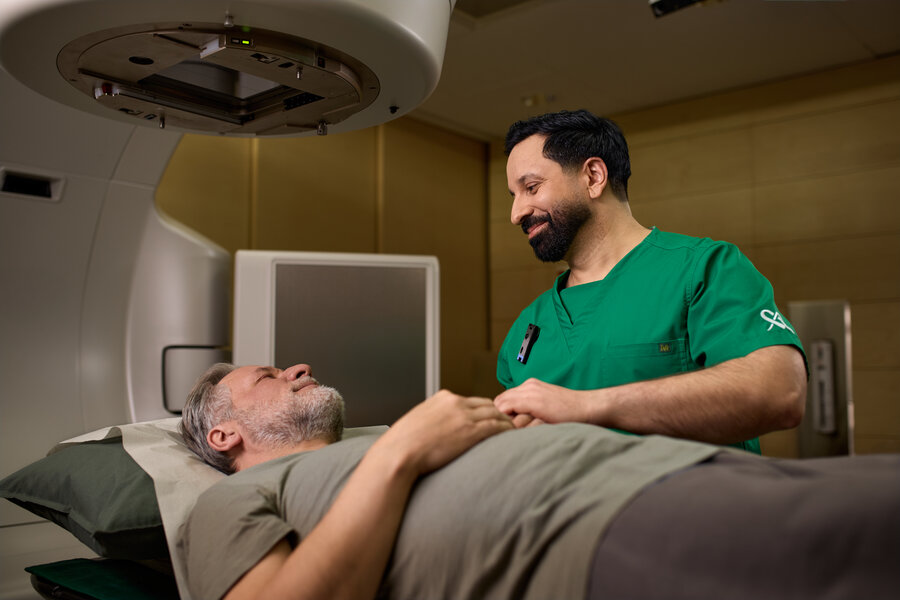We apologize for delays in customer service and transactions.
We are updating our hospital's information systems, and this may temporarily cause delays in customer service and transactions. We apologize...
Read moreMon–Fri 8–16

Prostate cancer treatment is always designed individually according to the characteristics of the disease. The choice of treatment is influenced by other possible diseases, possible references to so-called high-risk prostate cancer, the results of prevalence studies and, of course, the patient's own wishes.
After developing prostate cancer, many patients face a challenging situation with different treatment options. When weighing different treatments, it is important that diagnostic tests and treatment recommendations are based on the latest medical research evidence and perceived data. At Docrates Cancer Center, the patient and relatives are always given special consideration when discussing different treatment options, their advantages and disadvantages.
Local or locally advanced prostate cancer can be increasingly cured with radiation therapy. Radiation therapy has established itself as an effective treatment for prostate cancer in the 21st century. Surgery can also be curative if the cancer is completely localized.
Leaving prostate cancer to active monitoring is controversial in local low-risk prostate cancer in light of current knowledge.
Indeed, individual studies, such as cancer gene profiling, may provide indications of new cancer therapies worth experimenting with. At Docrates Cancer Center knowledge on cancer gene profiling has been utilized already for a long time.
Depending on the characteristics of prostate cancer, radiation therapy can be tailored in many different ways. There are several different techniques to choose from in external radiotherapy, and radiotherapy can also be given as interstitial form or radiotherapy (HDR brachytherapy). In aggressive cancers, the best treatment outcome is most likely to be obtained by combining external beam radiotherapy with high-dose HDR brachytherapy. Based on risk factors, radiotherapy can also be combined with cancer drugs.
Depending on the individual’s needs, the patient may also be advised to visit a urotherapist, physiotherapist or, for example, a specialist in nutrition or sexual therapy. They can provide home care instructions, for example, for recovery exercises and general well-being.
Most commonly, drug treatment is given in advanced prostate cancer, but also in high-risk local cancers as adjunctive therapy.
New drugs are often also suitable for elderly patients, with other diseases, and for use as part of combination therapies. These new prostate cancer drugs are often both more effective and better tolerated than previous drugs, and can also be effective when previous drugs have already lost their effectiveness. New drugs can relieve symptoms, slow the progression of the disease, especially in the bones, and prolong life. At Docrates we utilize the newest drug treatments available.
Advanced prostate cancer can be treated effectively, and treatment should always be individually planned. First-line treatment always includes drug therapy, most commonly hormonal therapy and chemotherapy, or a combination, and often a bone-strengthening drug if the cancer has spread widely to the bone.
In addition to traditional prostate cancer therapies, we use isotope therapies such as radium-223 and samarium therapy. As the newest entrant, we started 177-lutetium-PSMA treatments in early 2017. 177-lutetium-PSMA treatments also allow for the effective destruction of extra-skeletal metastases without serious side effects, whereas isotope treatment with a radiopharmaceutical applied to the skeleton (radium or samarium) has been shown to be effective and safe when the metastases are only in the skeleton.
The VISION study results* were presented in ESMO2021 conference: the results showed that treatment with 177-lutetium-PSMA significantly improved overall survival (OS) in patients with PSMA-positive metastatic castration-resistant prostate cancer.
*Publiced in NEJM September 2021
We have also adopted the 225-actinium-PSMA treatment, which is still an experimental drug treatment with a special permission for compassionate use by the Finnish Medicines Agency (Fimea). Preliminary research results on 225-actinium-PSMA treatments are promising and, alongside 177-lutetium-PSMA treatments, offer a new opportunity for the treatment of advanced prostate cancer. These can also be used together as so-called tandem or combination therapy.
Our hospital is constantly conducting various clinical trials, which may open up completely new treatment options for the patient. Read more.
We are updating our hospital's information systems, and this may temporarily cause delays in customer service and transactions. We apologize...
Read more
Docrates Cancer Center will open its first clinic in Sweden. Located in Stockholm, the new clinic will offer Swedish patients...

Reconstructing a removed breast is part of the treatment path of many breast cancer patients. The goal of the surgery...

New forms of treatment based on molecular diagnostics enable more and more patients to completely recover from cancer, and make...
Contact us!
Mon-Fri 8:00–16:00
